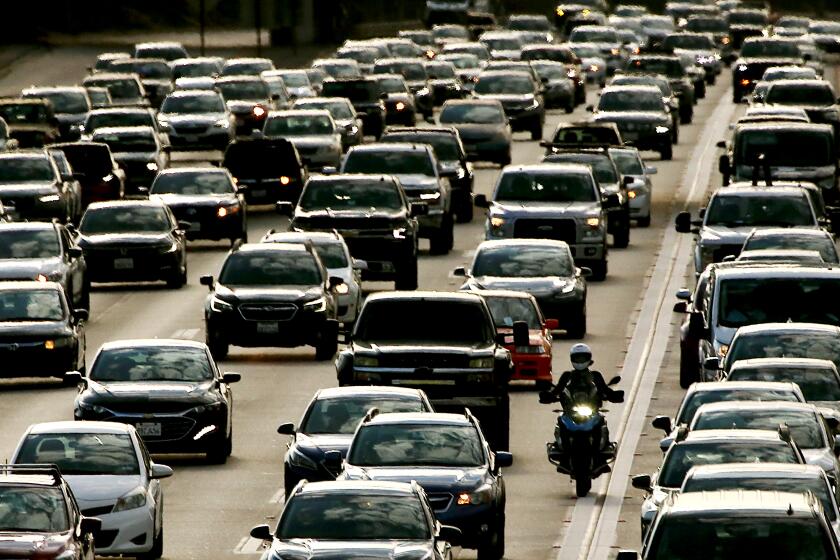
Gov. Gavin Newsom’s office announced a new campaign Monday at Climate Week NYC to encourage 1 million Californians to take everyday actions to help combat climate change.
“Every day, Californians are taking small actions that collectively are helping us create a better world for our kids and grandkids,” Newsom said in a prepared statement. “The Climate Action Counts campaign will empower Californians to be a part of something big and impactful.”
The campaign encourages Californians to pledge that they will take “everyday actions” to fight global warming, such as composting, taking public transit instead of driving and planting trees or native plants. Details can be found at the new Climate Action Counts website.
The California Air Resources Board reports that state carbon emissions dropped about 9.3 million metric tons in 2022 compared to 2021.
Officials unveiled the campaign as a kickoff to several California-focused events at Climate Week NYC. The gathering, which is held every year in New York, is intended to bring together climate leaders from government, industry and activism to seek and promote solutions to global warming.
The climate pledge is intended to help motivate Californians to live more sustainable lives, reduce their reliance on planet-warming fossil fuels and combat the feeling of anxiety and helplessness that can come with climate change.
The campaign builds upon the California Climate Action Corps, a volunteer program aimed at addressing climate change, which the governor’s office announced at Climate Week NYC four years ago. Since then, the program has grown to 400 members and has become a model for other states and the White House’s American Climate Corps.
“We’ve already engaged tens of thousands of volunteers,” said Josh Fryday, chief service officer with the governor’s office. “What we’re hoping to do now is to supercharge our efforts to mobilize Californians by engaging 1 million people to take these simple, everyday actions that add up to real impact.”
In order for California to reach its ambitious climate goals, large swaths of the population must drastically reduce their emissions by transitioning to electric vehicles and replacing natural gas heating in their homes, said Christopher Jones, a carbon footprint researcher and director of the CoolClimate Network at UC Berkeley.
The pledge itself likely won’t make much of a dent in emissions, Jones said, but with state policies already effectively eliminating the use of fossil fuels in the coming decades, Climate Action Counts could help warm up Californians to climate action and the needed lifestyle changes.
“The reality is, the big actions are not on this list,” he said. But the pledge can get Californians to realize “this is who we are — Californians are cool. Californians care about the environment. Californians identify as leaders in this area.”
The campaign focuses not only on lowering emissions but also on reducing waste and pollution, and encouraging people to connect with nature and their communities.
However, experts say convincing individuals to take up new habits through communication and pledges alone can be a challenge.
Based on research, “it’s very clear that stronger incentives are going to work better than simply communicating,” said Seth Wynes, a professor at the University of Waterloo in Canada who studies the effects of individual actions on the climate. “People are not going to just give up their car and bike to work if it’s extremely dangerous to bike.”
A sudden shutoff of water supplies has dried up the Kern River in Bakersfield, leaving thousands of dead fish on the parched riverbed.
This is not the first time officials have called on Californians to change their habits. In 2008, the state launched a campaign encouraging Californians to upgrade the energy efficiency of their homes and conserve electricity. While the campaign may have moved the needle, it fell short of its initial goals.
During the 2012-16 drought, the state aimed to curb water use habits with public messaging, water use restrictions and incentives to increase water efficiency. Although per-capita water use increased when restrictions were lifted, it has remained lower than pre-drought levels — an indication that many Californians had permanently changed their habits.
The governor’s office also plans to work with local partners to reach Californians in their own communities, which experts say can boost the effectiveness of campaigns like these.
“Together, we can create collective impact,” said Fryday, “and our partners, by organizing people on campuses and in the workplace and in their cities, are going to demonstrate that we can do this.”
The announcement of a California campaign at Climate Week NYC is in keeping with the gathering’s ethos. Organizers ask participants to come ready to share a problem or vulnerability they need help addressing, and they put some pressure on attending organizations and governments to announce new goals and efforts.
“It’s always a competition, too. … We instigate it all the time,” said Angela Barranco, the executive director for North America at Climate Group, the charity organizing the event. “There’s a pressure to show up with something actually delivered, and I think we have to keep that pressure going.”
Climate Week started in 2009 as a series of smaller panel discussions, aimed at encouraging global leaders at the nearby United Nations General Assembly to talk about climate issues.
Since then, the focus has shifted from talking about the problem to inspiring action. California has taken on a leading role in those efforts, and now represents North America as a co-chair for a group of governments committed to reaching net zero emissions by 2050.
“California shows up and really puts resources behind much of the ambition they have,” Barranco said. “So they’ve become experts at the table — for not just the United States.”









